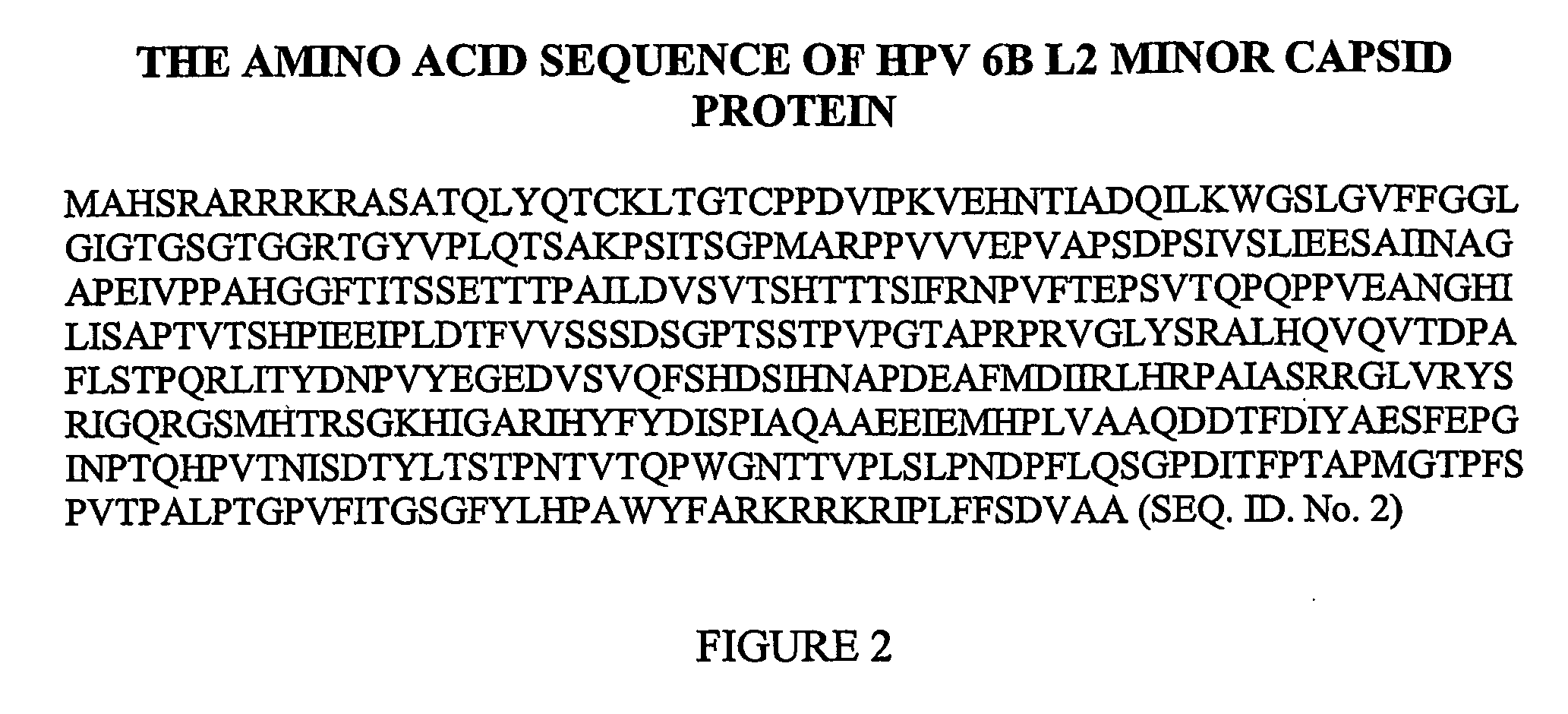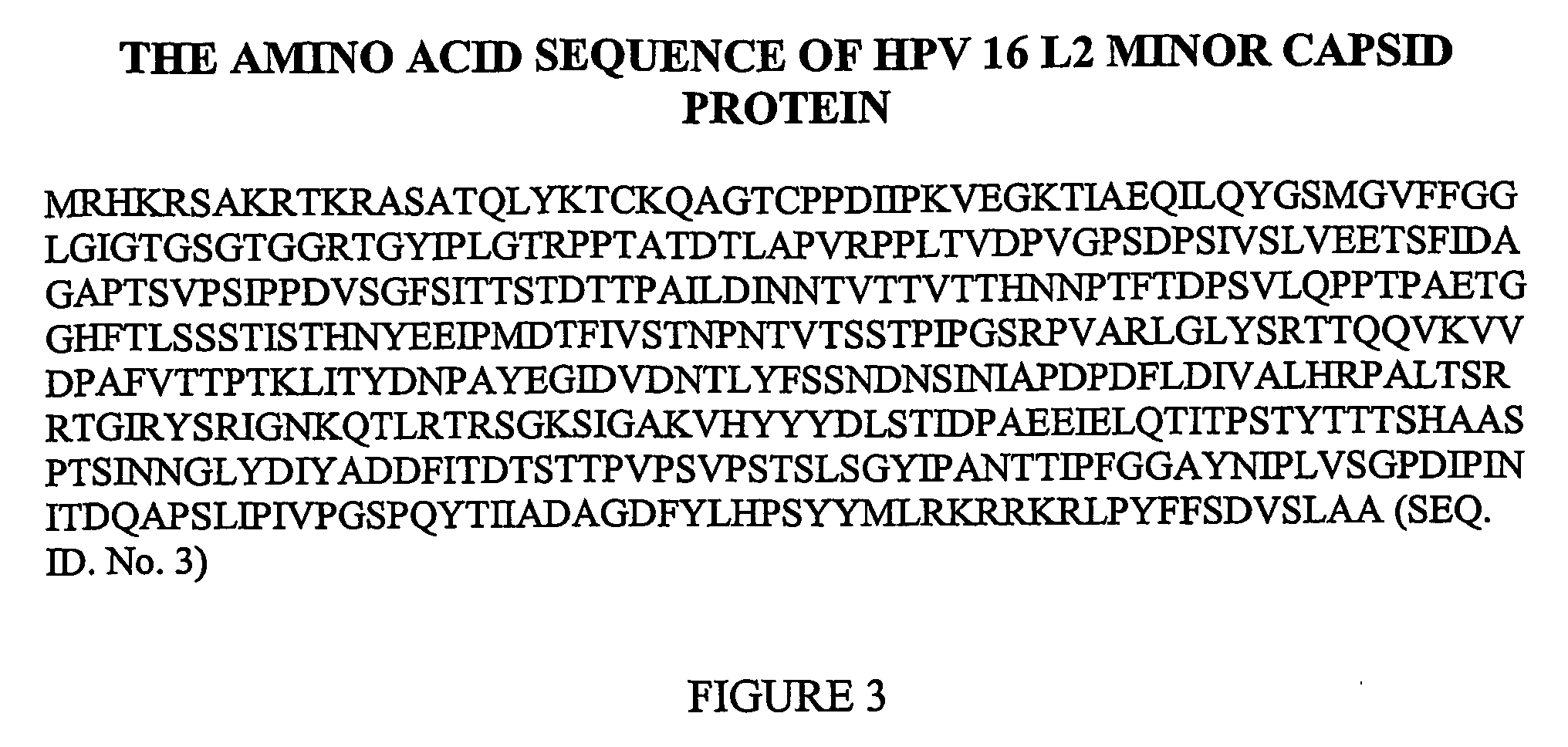Therapeutic and prophylactic vaccine for the treatment and prevention of papillomavirus infection
a papillomavirus and prophylactic vaccine technology, applied in the field of papillomavirus therapy and prophylactic vaccine for the treatment and prevention of papillomavirus infection, can solve the problems of relatively high production cost of vaccines, inability of canine and rabbit papillomaviruses and inability to induce papillomas in heterologous species
- Summary
- Abstract
- Description
- Claims
- Application Information
AI Technical Summary
Benefits of technology
Problems solved by technology
Method used
Image
Examples
example 1
HPV 11 Bacterially Expressed L1 Protein Reacts with Conformational Antibodies
[0077]See, Li, M., et al., J. Virol., 71:2988-2995 (1997), which is hereby incorporated by reference.
example 2
Co-Expression and Purification of HPV11 L1 and L2 Proteins from E. Coli
[0078]HPV11 L1 and HPV11 glutathione-S-transferase (GST) L2 fusion proteins were co-expressed in E. coli by the following methods. It is noted that the particulars of this cloning and purification process are not essential to the invention and many different methods to generate the same results will be apparent to those skilled in the art. HPV11 L1 protein was expressed from a pET17b vector that confers ampicillin resistance (available from Novagen, Madison Wis.). HPV11L2 (or portions thereof) was expressed as a GST fusion protein from the vector pXA / BN, which confers chloramphenicol resistance, and also facilitates purification of L2 by glutathione-sepharose chromatography. L2 and L1 expressing vectors are co-transformed into competent E. coli BL21(DE3) (available from Novagen, Madison Wis.) under chloramphenicol and ampicillin selection. A single isolated colony of co-transformed bacteria was inoculated into 5...
example 3
Cloning and Construction of Deletion and Site-Directed Mutants of HPV 11 L2 Capsid Protein; Identification of an HPV11 L1 Binding Domain within HPV11 L2
[0080]Full length HPV11 L1 DNA. Full length HPV11 DNA sequence was obtained by PCR amplification from plasmid pVL11L1 (obtained by methods outlined in Rose, et al., J. Virol, 67:1936-44 (1993)) with the forward primer 5′-GCCGCGAAGCTTCATATGTGGCGGCCTAGCGCAG (SEQ ID NO. 5), containing an NdeI restriction enzyme site at the initiator methionine codon, and the reverse primer, 5′-GGGCCTGGATCCAGATCTCACAACACACACTGACACAC (SEQ ID NO. 6). The PCR-amplified fragment was subcloned into a PCR II vector (Invitrogen), using manufacturer's protocols. An NdeI / BstX1 fragment encompassing the amplified sequences was excised from this intermediate vector, purified and then ligated to similarly-digested pET17B vector (Novagen) to generate pET17b-HPV11 L1.
[0081]b. HPV L2 DNA. The pXA / BN-based vectors, used for expressing HPV11 GST-L2 fusion proteins and al...
PUM
| Property | Measurement | Unit |
|---|---|---|
| Nucleic acid sequence | aaaaa | aaaaa |
| Immunogenicity | aaaaa | aaaaa |
Abstract
Description
Claims
Application Information
 Login to View More
Login to View More - R&D
- Intellectual Property
- Life Sciences
- Materials
- Tech Scout
- Unparalleled Data Quality
- Higher Quality Content
- 60% Fewer Hallucinations
Browse by: Latest US Patents, China's latest patents, Technical Efficacy Thesaurus, Application Domain, Technology Topic, Popular Technical Reports.
© 2025 PatSnap. All rights reserved.Legal|Privacy policy|Modern Slavery Act Transparency Statement|Sitemap|About US| Contact US: help@patsnap.com



